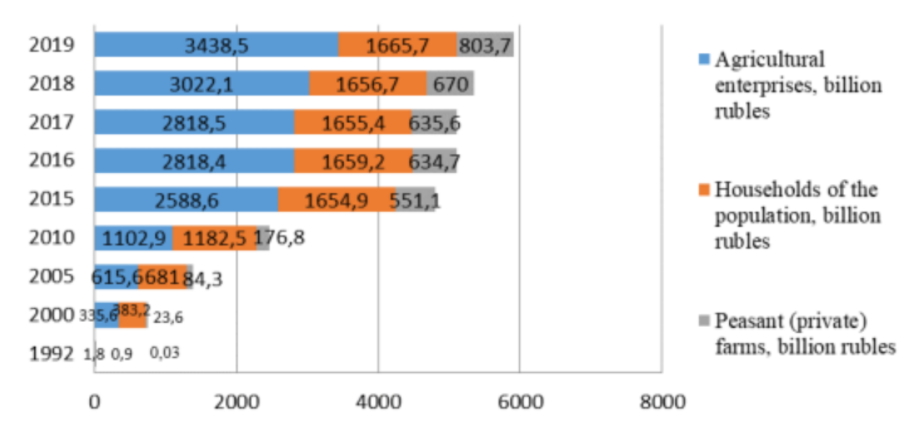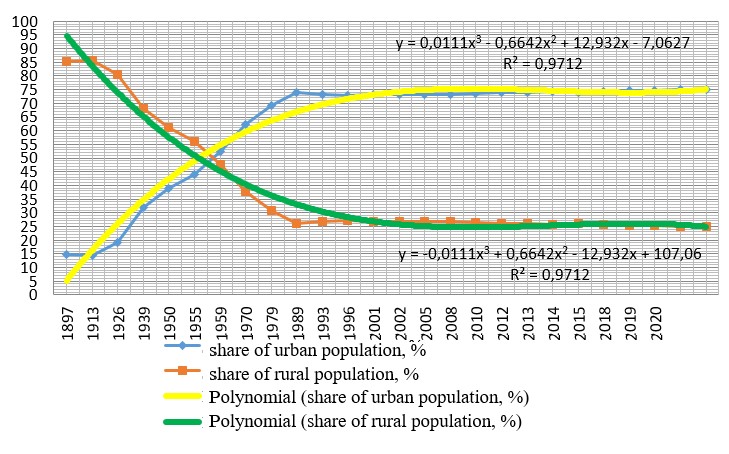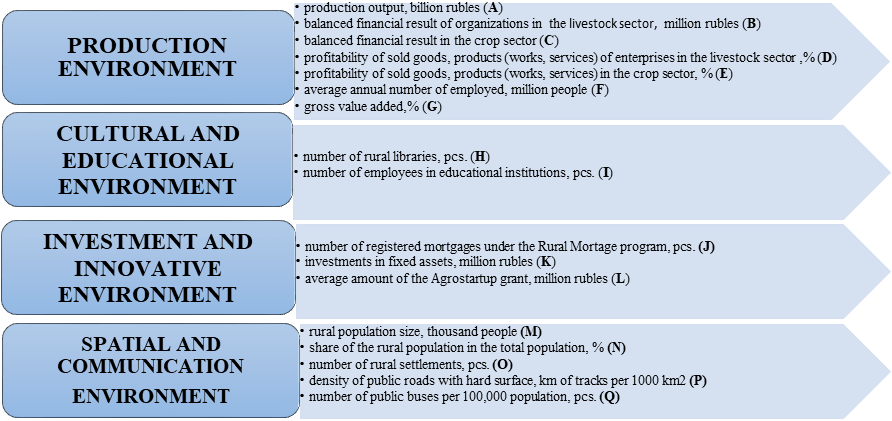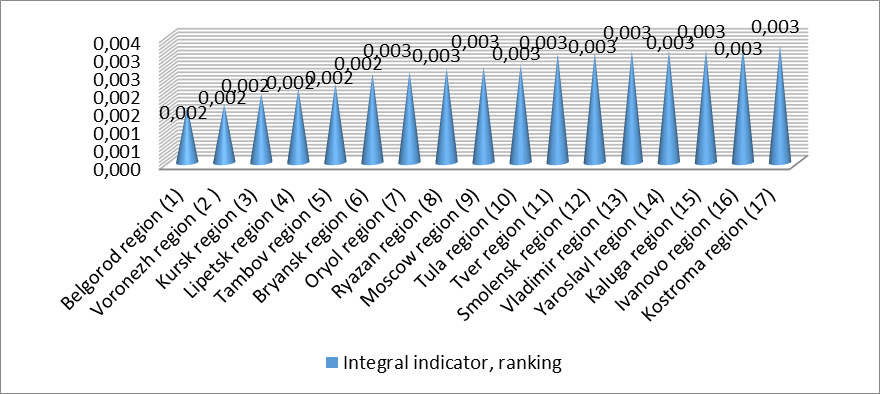Abstract
The paper deals with the problems related to the peculiarities of modern development of rural areas. Rural areas are a strategic resource for the development and economic growth of any country, which relevance is obvious due to economic globalization, uneven territorial distribution of natural resources, and environmental deterioration. In recent decades, the agro-industrial complex has shown steady growth, but this trend weakly correlates with the level and quality of life of the population in rural areas. The problem of potential access to quality educational services, cultural institutions and information resources reveals the gap between the urban and rural population that leads to an outflow of the population from unpromising rural areas. Rural areas are considered in terms of the development of their agricultural capabilities and territory. The methodology proposed by the authors is aimed at analyzing rural areas by four parameters: production environment, cultural and educational environment, investment and innovative environment, spatial and communication environment. Each parameter includes a set of indicators. The methodology allows ranking of the regions with rural areas. Identified weaknesses in the development of rural areas enables development of a set of measures to create conditions for a stable increase in the quality and standard of living of the rural population based on the advantages of the rural life, and to maintain social control and development of rural areas.
Keywords: Agro-industrial complex, innovative environment, rural areas
Introduction
In order to assess the impact of rural areas on the innovative environment of the region and identify problems of their development, it is necessary to consider these problems at the intersection of the agricultural and population geography.
The settlement of the region is determined by the proximity to any resources such as the availability of water and fertile land to ensure and maintain people's lives. In the process of evolution of human activity, the entire territory fell into urban areas, with the prevalence of activities not related to agriculture, for example, trade, handicrafts, management and education structures, and rural ones, with the dominance of agriculture or forestry, commercial hunting and fishing.
The choice of a place of residence is determined by the region potential, and the population seeking for the increased level and quality of life moves from lower rank areas to higher ones. However, the superiority of urban areas over rural ones was not always so obvious. In the work by Leshchenko and Ignatiev (2011), it is reported that in the Middle Ages the city '... was considered a nasty place, a center of sin (public display of begging, prostitution, urban robbery) and temptations unworthy of a Christian. The most unworthy were driven into the city. The city was replenished by disinherited sons, landless widows, rural idlers and other people, one way or another, found themselves out of business .... In the period of Renaissance, the values changed and 'soon the predominance of industrial interests over agricultural ones became evident, the rural population moved to cities, huge masses of poor people grouped in industrial centers, the importance of the land aristocracy declined, and the cotton lords, the owners of large cotton factories, finally became dangerous rivals of landlords, the owners of lands (Dobrolyubov, 1911).
Russia covers about 30 % of the territory of Eurasia and 12 % of the entire land, and occupies an area of 17,125,191 km² in 2021. Based on the current legislation of the Russian Federation, the entire land fund is divided into certain categories of land. Agricultural lands occupy 22 % of the total land fund.
Agricultural land is the basis of food security. The production of safe food helps to improve the health of the nation, increase the human potential of the state, and strengthen its role in the international arena.
A total of 102.9 thousand enterprises engaged in agriculture, forestry, hunting, fishing and fish farming are established in Russia. The volume of production by categories in 1992–2019 is shown in Figure 01.

Problem Statement
The problems of investigating rural areas are associated primarily with the weak statistical coverage of these territories and the absence of development criteria. The study on the development of rural areas is relevant.
In the modern conditions of the socio-economic development of the Russian Federation, the problems that have been accumulating for decades caused a rapid reduction in rural areas and an outflow of the population to more economically developed territories. At the same time, agriculture is the basis of the national food security, a source of economic growth, and part of the regional innovative environment. The spatial and communication environment of the population requires significant modernization to increase the opportunities for employment in rural areas and to eliminate the gap between opportunities for the urban and rural population.
In this regard, the transformation of rural areas is a priority task, a scientifically substantiated methodology for assessing rural areas has not been developed yet. When the region neglects the peculiarities of rural areas, approaches to the development of these areas are standardized, which significantly slows down the process of development.
Research Questions
With due regard to the purpose of the study, it is necessary to solve the following tasks:
- to define the content of the definition;
- to analyze the state of development of rural areas in the Russian Federation;
- to improve the methodological tools for assessing the development of rural areas
Purpose of the Study
The purpose of the study is to analyze the development of rural areas and assess their impact on the regional innovative environment.
Research Methods
The information base of the study was the data obtained by the Federal State Statistics Service, the territorial statistics service of the regions of the Central Federal District, statistical and operational information of local self-government bodies, regional and municipal programs for the socio-economic development of territories, proceedings of scientific and practical conferences, papers of periodicals, and personal observations of the authors.
The study employed a system-functional approach to the analysis of rural areas. Theoretical approaches are based on induction-deductive methods and models, and on the conventional scientific methods such as analysis, synthesis, generalization, comparison and modeling.
The following tools of economic analysis was used to develop a methodology for assessing rural areas: economic and statistical grouping, rating analysis, trend extrapolation, graphic interpretation.
Findings
At present, successful agricultural practices are associated with innovative progress (Stovba & Stovba, 2015). The goal of agricultural innovation is not only the achievement of positive financial results or market share targets. It is also more important than reaching the target number of users. Effective agricultural innovation is about delivering high value to end users and improving their quality of life and well-being. To achieve this goal, enterprises must be aware of the concept of work to be performed for end users. They should take into account requests of users. Understanding user needs is as important as technologies for finding innovative solutions. In Russia, advanced agricultural technologies are poorly implemented due to insufficient financial resources and adherence to traditional farming (Cherik, 2020; Kovtun et al., 2019). Thus, the efficient use of the available labor force becomes difficult, and a high level of unemployment can be observed along with the limited opportunities for employment. The level of rural unemployment is not precisely known either in the existing agricultural practices, or potentially with the use of advanced agricultural technologies. Due to insufficient data on the unemployment rate, it is impossible to take effective and efficient measures to develop appropriate policies to address the problem of employment in agriculture. A global trend in recent years is a decrease in the number of people engaged in agriculture due to increased productivity and production of agricultural enterprises (Strelka, 2019; Sysoeva & Mahonina, 2020).
However, in the Russian Federation, both the number of people engaged in agriculture (decreased by 171 thousand people compared to 2018) and labor productivity (decreased by 6% by 2019) are decreasing. In addition, the growth rate of labor productivity (94.3%) is lower than the growth of wages (109.7%), which indicates the stagnation of agricultural activity and ineffective use of the wages fund and labor resources.
Despite the rapid growth of the industrial sector, agriculture plays an important role in the national economy (Karpunina et al., 2019).
In fact, agriculture created job opportunities for 7% of the working-age population, contributed 3.8% of gross value added, and produced almost 75% of raw materials processed by the country's agro-industrial complex. In addition, foreign exchange earned from agricultural exports ($ 24.8 billion 2019) contributed to industrial development.
The vital role of agriculture in the national economy will increase with more efficient use of available agricultural resources, which requires both technological and economic measures (Campos, 2021; Merkulova & Sysoeva, 2013). The development of most suitable production plans for individual farms and the mobilization of agricultural production in accordance with these plans are crucial for the development of rural areas.
Institutions play an important role in the agricultural development. On the one hand, institutions act as an endogenous variable along with other elements and contribute to the development of the agricultural economy. On the other hand, institutions act as an exogenous variable to guarantee, stimulate, block, or induce other factors. With regard to the process of agricultural development, the development regime corresponding to each stage of agricultural development is supported by relevant institutions. Any transformation of the agricultural development regime depends on institutional innovations, since it provides not only the necessary incentives and deterrent mechanism for agricultural enterprises, but also an appropriate institutional environment for agricultural development.
Russia is dependent on agriculture (Gumerov & Guseva, 2019; Yarkova & Lukashin, 2019). Farming involves many risks, both production and market ones. These problems directly affect agricultural manufacturers, who lose potential profits and are burdened with debt, which leads to bankruptcy and waste of natural resources. All this is counterproductive for the rural economy. Insurance should become the main institution that contributes to the agricultural development, including innovative one. The best use of the benefits depends on the state of a particular manufacturer. Each manufacturer, who issued an insurance policy, must be in the unified register of the state, where information about the manufacturer and farming conditions is stored (Menyaykin & Talanova, 2016; Nikitina, 2019; Stepanova & Rozhkova, 2020). The proposed methodology will yield the following benefits:
- The land and crops of the manufacturer will be insured to eliminate the risk of bankruptcies;
- The advisory board should assist in educating manufacturers and solving their problems;
- The government will be aware of the state of the nation in terms of production and soil fertility in rural areas.
- The government will gain extensive data on the total production for the year, the total area of land used for production, the state and quality of various regions of the country, and other statistics;
- The reorganization of management will help to know a more precise structure of investments required in the agricultural sector.
Russia, the largest country in the world by area, ranks only 7 in terms of the average annual population (China – 1,398 million people, India – 1,312 million people, USA – 328.2 million people, Indonesia – 266.9 million people, Brazil – 210.1 million people, Bangladesh – 166.5 million people, Russia – 146.7 million people) according to the data reported by the Federal State Statistics Service in 2019.
The urbanization tendency and the decreased share of the rural population confirm the constructed trend equation (Figure 02), which can yield the level of less than 25% of the rural population in the total population of the Russian Federation.

In order to give recommendations for the development of rural areas, it is necessary to determine the characteristics of the development of rural areas. We propose to assess rural areas by the following parameters: production environment, cultural and educational environment, investment and innovative environment, spatial and communication environment, which are grouped based on national functions specified in the Strategy for Sustainable Development of Rural Areas of the Russian Federation up to 2030, approved by the order of the Government of the Russian Federation of February 2, 2015 No. 151-r and signed by the Chairman of the Government of the Russian Federation D. Medvedev (Decree of the Government of the Russian Federation No. 151-r, 2015). The indicators included in the system of parameters are presented in Figure 03.
We tested the methodology for assessing rural areas by assessing the regions of the Central Federal District of the Russian Federation, except for Moscow, since it is a city of federal significance, the administrative center of the Central Federal District, and a significant part of indicators characteristic of rural areas is absent.
The purpose of assessing the development of rural areas using these parameters is to reveal the current state of development of the region and identify the direction of transformations of these areas. This system of indicators is applicable to different regions of both the Russian Federation and foreign countries, and allows assessing the state of development of rural areas at different time intervals, which show the dynamics of measures to improve the development of the region.

Table 01 summarizes the indicator values taken from open sources. At the first stage, we consider the mean values as a fraction of the maximum value of the reference region and determine its proximity to other regions (Table 02). The region with the indicator of development of rural areas equal to one is the most developed. However, it should be noted that high indicators may correspond to the worst value, and vice versa, low indicators correspond to the best value. In this methodology, the best value corresponds to a high indicator.
At the second stage, the composite index of development of rural areas is calculated using the geometric mean. The third stage of rating calculation is performed using the distance method. The integral indicator with the highest value indicates the lowest rating position among the analyzed regions according to the selected parameters (Figure 04).

The results of calculating the integral indicator show that the leading regions with developed rural areas are Belgorod, Voronezh and Kursk regions. Kaluga, Ivanovo and Kostroma regions lag behind in the development of rural areas. The calculation of aggregated regional indicators shows the current state of development of rural areas and allows decisions on their transformation.
Conclusion
The study of the modern development of rural areas yielded the following conclusions. In the Russian Federation, the development of rural areas is a priority task, which is evidenced by various state programs aimed both at the agricultural development and at the increased quality of development of these areas. The innovative agricultural development contributes to the increased labor productivity and caring attitude to the environment. Improving the infrastructure of rural areas stimulates the population to organize and run their own businesses and settle down in rural areas. The developed methodology for assessing rural areas reveals the current state of development of rural areas and provides an opportunity for making managerial decisions on their transformation.
References
Campos, H. (2021). The innovation revolution in agriculture. Retrieved from https://www.researchgate.net/publication/348121633
Cherik, O. V. (2020). Promising directions of solving socio-economic problems of rural territories. Academy of Law and Administration of the Federal Penitentiary Service of Russia, 3(45), 23–26.
Decree of the Government of the Russian Federation No. 151-r of 02.02.2015. Strategies for sustainable development of rural territories of the Russian Federation for the period up to 2030. Retrieved from https://www.consultant.ru/
Dobrolyubov, N. A. (1911). Robert Owen and his attempts at social reform. V. Nikitin’s publishing.
Gumerov, R. R., & Guseva, N. V. (2019). Integrated development of rural territories: does the new state program meet modern challenges? Management and business administration, 4, 97–107.
Information resource containing data on information and library services for children in the Russian Federation. Retrieved from https://stat.rgdb.ru/component/method/?view=regions&Itemid
=0&id=23-
Karpunina, E. K., Gorbunova, O. N, Moiseev, S. S., & Cheremisina, T. N. (2019). Resistante is not hopeless… Regarding the policy of countering information threats of economic security. Education excellence and innovation management through vision, 2679–2686.
Kovtun, B. A., Papelo, V. N., & Yarmanov, V. V. (2019). Integrated rural development: factors. institutes and mechanisms of advanced development. IC NGAU Golden Ear.
Leshchenko, O. A., & Ignatiev, M. N. (2011). Modernization of Russia: territorial dimension. Aletheia.
Menyaykin, D. V., & Talanova, A. O. (2016). The concept and essence of rural territories. Economics and Business: Theory and Practice, 4, 113–116.
Merkulova, E. Yu., & Sysoeva, M. S. (2013). Mechanisms of functioning of an innovative enterprise in the region. Socio-economic phenomena and processes, 7(53), 99–105.
Nikitina, T. I. (2019). The state of the health sector as a factor of sustainable socio-economic development of rural areas. Bulletin of the Chelyabinsk State University, 9(431), 235–245.
Official website of the Federal State Registration Service, cadastre and cartography. Retrieved from https://rosreestr.gov.ru/site/press/news
Official website of the Federal State Statistics Service of the Russian Federation. Retrieved from https:// www.gks.ru
Stepanova, E. V., & Rozhkova, A. V. (2020). The role of socio-cultural institutions in the education of young people in rural territories. Azimuth of Scientific Research: Pedagogy and Psychology, 9(3(32)), 248–252.
Stovba, E. V., & Stovba, A. V. (2015). Innovations as a factor of sustainable development of rural territories. Modern research of social problems, 5(49), 706–719.
Strelka, E. A. (2019). Actualization of the content of the categories Strategic planning of rural development and Transformation of the philosophy of management in rural areas. Economy of agriculture of Russia, 11, 101–105.
Sysoeva, M. S., & Mahonina, I. N. (2020). The impact of the economic crisis of 1998, 2008, 2020 on business structures: a comparative aspect. In Problems of the development of the national economy at the present stage: proceedings of the International Scientific and Practical Conference (pp. 325–333). Derzhavinsky Publishing House.
Yarkova, T. M., & Lukashin, N. A. (2019). The current state of the social infrastructure of rural territories (on the example of the Perm Region). Bulletin of Prikamsky Social Institute, 3(84), 62–68.
Copyright information

This work is licensed under a Creative Commons Attribution-NonCommercial-NoDerivatives 4.0 International License.
About this article
Publication Date
01 February 2022
Article Doi
eBook ISBN
978-1-80296-123-2
Publisher
European Publisher
Volume
124
Print ISBN (optional)
-
Edition Number
1st Edition
Pages
1-886
Subjects
Land economy, land planning, rural development, resource management, real estates, agricultural policies
Cite this article as:
Sysoeva, M. S., Makhonina, I. N., Merkulova, E. Y., Turbina, N. M., Cheremisina, T. N., & Cheremisina, N. V. (2022). Analysis Of Rural Areas Development And Their Impact On Regional Innovative Environment. In D. S. Nardin, O. V. Stepanova, & E. V. Demchuk (Eds.), Land Economy and Rural Studies Essentials, vol 124. European Proceedings of Social and Behavioural Sciences (pp. 831-840). European Publisher. https://doi.org/10.15405/epsbs.2022.02.103

